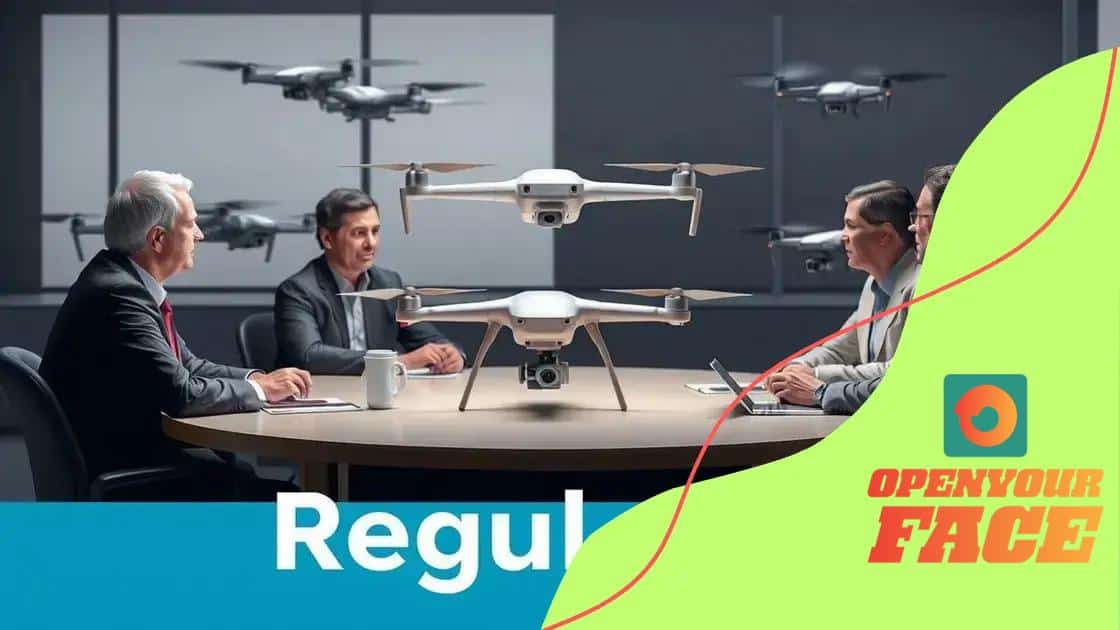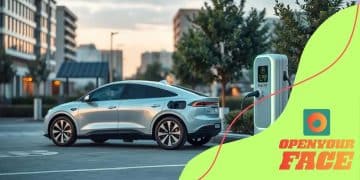How autonomous drones are changing logistics and delivery

Autonomous drones are changing logistics and delivery by providing faster, cost-effective solutions, enhancing efficiency in supply chains, and expanding delivery capabilities across various sectors.
How autonomous drones are changing logistics and delivery is a question that many are beginning to explore. Imagine waiting for a package and having it arrive within minutes, thanks to drone technology. This evolution in delivery is not just about speed; it’s reshaping entire supply chains.
The rise of autonomous drones in logistics
The rise of autonomous drones in logistics is reshaping how goods are transported and delivered. As technology evolves, these unmanned aerial vehicles are becoming essential in many industries. Their ability to deliver packages quickly and efficiently offers significant advantages.
Technological Advancements Driving Drone Usage
Several innovations have led to the increased use of autonomous drones in logistics. From advanced navigation systems to better battery life, these improvements enhance performance. Some notable advancements include:
- GPS and mapping technologies that allow for precise navigation.
- AI algorithms that optimize flight paths and ensure safe deliveries.
- Improved battery efficiency that extends the range of deliveries.
- Collision avoidance systems that enhance safety during operations.
These technologies enable drones to operate in various environments, making them versatile tools for logistics companies. Drones are being embraced not only for their speed but also for their ability to reduce costs.
Impact on Supply Chains
The inclusion of drones in logistics has a unique impact on supply chains. By enabling faster deliveries, companies can respond to customer demands more swiftly. Businesses can now offer same-day and even hour delivery, elevating customer satisfaction levels significantly. Moreover, autonomous drones help lower carbon footprints compared to traditional delivery vehicles, contributing positively to sustainability goals.
Moreover, the integration of drones helps streamline inventory management. By providing real-time data about inventory levels, companies can optimize stock levels and reduce excess inventory. This means businesses can save both time and money while enhancing their efficiency.
Challenges to Overcome
Despite the many benefits, challenges still remain in the adoption of autonomous drones in logistics. Issues such as regulatory restrictions and air traffic control need attention. However, as regulations adapt to technological advancements, the potential for drones will only expand.
Public acceptance is another area to consider. Many people are still uncertain about drones flying overhead in urban areas. Educating the public about the benefits of drones can foster acceptance and encourage their use.
In summary, the rise of autonomous drones in logistics is a testament to technological innovation. As challenges are addressed, these drones are poised to revolutionize delivery systems across various sectors.
Benefits of using drones for delivery
The benefits of using drones for delivery are numerous and impactful. As companies increasingly adopt drone technology, they discover significant advantages that enhance their operations and customer satisfaction. From speed to efficiency, drones are transforming traditional delivery methods.
Speed and Efficiency
One of the most significant advantages of using drones is their ability to deliver packages swiftly. Unlike traditional delivery methods, drones can navigate directly to their destinations without being hindered by traffic or road conditions. This results in faster delivery times, which is crucial for businesses aiming to meet customer expectations. Additionally, drones can operate on demand, allowing for quick responses to urgent delivery needs.
- Reduced delivery times, often completing tasks in minutes.
- On-demand services that adapt to customer requests.
- More efficient use of resources, minimizing the need for delivery vehicles.
- Ability to reach remote locations easily, expanding service areas.
In urban areas, drones can bypass traffic jams, ensuring timely arrivals. This efficiency leads to higher customer satisfaction and increases repeat business.
Cost Savings
Another notable benefit of drone delivery is the potential for cost savings. While the initial investment in drone technology can be significant, the long-term savings can outweigh these costs. Drones require less maintenance than traditional delivery vehicles and do not consume fuel. This translates to lower operational costs.
Moreover, drones can optimize routes in real-time, which further reduces costs associated with delays and fuel consumption. Over time, businesses can see a noticeable decrease in expenses related to human labor and vehicle upkeep.
Environmental Benefits
Drones also offer environmental benefits, promoting sustainability. Compared to traditional gas-powered delivery trucks, drones produce fewer emissions. This makes them an attractive option for companies looking to enhance their green initiatives. By switching to drone delivery, businesses can contribute to lowering their carbon footprint.
Many companies are finding ways to integrate electric drones into their logistics, which can further reduce environmental impact. This shift not only helps the planet but also appeals to environmentally conscious consumers.
In summary, the benefits of using drones for delivery are clear. They offer enhancements in speed, cost efficiency, and environmental responsibility. As technology continues to advance, the applications and advantages of drone delivery will only expand further, offering exciting possibilities for the future of logistics.
How regulatory changes are shaping drone use

Changes in regulations are significantly impacting how drones are used in logistics. The evolving legal landscape aims to ensure that the operations of autonomous drones remain safe and efficient, allowing businesses to utilize this technology more effectively.
Recent Regulatory Developments
Governments are progressively adapting their regulations to accommodate drone technology. New guidelines are being established to support safe flight paths and operational procedures. One major aspect includes the need for remote identification systems that allow authorities to monitor drone activities. These systems help enhance safety and are becoming a requirement in many regions.
- Implementation of remote ID systems for accountability.
- Creation of no-fly zones to protect sensitive areas.
- Approval processes for commercial drone operations.
- New rules regarding maximum flight altitude and distance.
These changes not only foster safety but also encourage the growth of the drone delivery market. Regulatory bodies are working closely with technology developers to ensure that regulations keep pace with advancements.
The Role of Safety Standards
Safety standards are paramount in shaping how drones operate within various airspaces. Drone manufacturers are required to comply with strict guidelines to ensure that their products are safe for use. These standards help prevent accidents and promote public trust in this emerging technology. Drones are now being equipped with advanced safety features such as collision avoidance systems and automated landing protocols, enhancing their reliability.
Moreover, pilot certification requirements are also being introduced, ensuring that drone operators are trained to handle their devices properly. This can lead to fewer accidents and increased confidence in drone deliveries.
Future Implications of Regulatory Changes
As regulations continue to evolve, they are likely to simplify the process of integrating drones into logistics further. Authorities plan to implement more streamlined certification processes for drone operations, making it easier for businesses to adopt this technology. Additionally, as public acceptance grows, laws may become more favorable toward expanded urban drone operations.
Continuous dialogue between regulators, industry leaders, and the public will be critical in shaping a future where drone logistics is commonplace. Overall, the regulatory landscape is crucial in determining how drones can operate effectively and safely in our skies.
Real-world examples of drone deliveries
Real-world examples of drone deliveries showcase how businesses are effectively integrating this technology into their operations. These case studies highlight the efficiency and convenience that drones offer in logistics.
Amazon Prime Air
One of the most notable examples is Amazon’s Prime Air service. Amazon is testing drone deliveries in select locations. These drones can deliver packages weighing up to five pounds within a 10-mile radius. Customers can expect to receive their packages in less than 30 minutes.
- Fast delivery times, enhancing customer satisfaction.
- Reducing road congestion by minimizing vehicle use.
- Expanding delivery areas to reach more customers.
This service aims to improve the overall shopping experience by making it faster and more efficient.
Wing Aviation by Alphabet
Another key player is Wing Aviation, a subsidiary of Alphabet. Wing has launched successful drone delivery services in parts of Australia and the United States. They deliver products like food, medicine, and retail items directly to customers’ doorsteps.
Wing’s approach focuses on maintaining safety and efficiency. Their drones can navigate complex urban environments while ensuring minimal disturbance. This service demonstrates the practicality of using drones in everyday life.
UPS Flight Forward
UPS has also entered the drone delivery space with its Flight Forward program. This service started by delivering medical supplies and packages to hospitals. It has been particularly valuable in urgent situations, such as during health emergencies.
- Facilitating rapid delivery of critical supplies.
- Improving service in hard-to-reach locations.
- Providing a reliable solution during urgent needs.
The Flight Forward program exemplifies how drones can enhance critical logistics, especially in healthcare. This demonstrates the versatility of drones across various sectors.
Zipline’s Medical Deliveries
Zipline operates in countries like Rwanda and Ghana, delivering blood and medical supplies to remote areas. Their drones cover long distances, ensuring that healthcare facilities receive essential materials without delay.
By improving access to medical supplies, Zipline’s impact is profound. It highlights the potential for drones to make a significant difference in communities with limited infrastructure.
These real-world examples of drone deliveries illustrate the benefits of this technology in enhancing logistics. As more companies explore drone capabilities, we can expect further advancements and applications in the future.
Future trends in drone logistics
The future trends in drone logistics promise exciting advancements that could revolutionize how goods are transported. As technology evolves, we can expect to see various innovations shaping the drone delivery landscape.
Increased Automation
One prominent trend is the rise of automation in drone operations. With advancements in artificial intelligence, drones will become more intelligent and capable of navigating complex environments. This will enhance their efficiency and reliability, allowing for more autonomous deliveries.
- Self-learning systems that adapt based on flight data.
- Improved route optimization to save time and energy.
- Enhanced communication networks for real-time updates.
As automation increases, we may see a decrease in the need for human operators, making deliveries faster and reducing operational costs.
Expansion of Delivery Services
Another significant trend is the expansion of delivery services into new sectors. We are beginning to see drone logistics enter fields such as agriculture, where drones can be used for crop monitoring and supply delivery, and emergency services, delivering medical supplies quickly. This diversification could lead to more widespread adoption of drone technology across various industries.
Furthermore, companies are exploring partnerships with local businesses to broaden their delivery networks. By collaborating with retailers and restaurants, drone services can cater to a larger audience and offer better service options.
Integration with IoT
As the Internet of Things (IoT) continues to grow, the integration of drones with IoT devices will become more prevalent. This relationship will enable drones to receive and send data seamlessly. For instance, drones can communicate with delivery hubs, adjusting their routes based on traffic and weather conditions.
Additionally, smart inventory systems can alert drones when stock is low, prompting automatic restocking deliveries. This synergy will streamline the supply chain, making it more responsive and efficient.
Regulatory Advances
Finally, regulatory changes will play a critical role in shaping the future of drone logistics. As lawmakers develop clearer guidelines, the drone industry will benefit from more widespread acceptance and integration into existing transportation systems. These regulations will help establish safe airspaces for drone operations and promote more competitive delivery services.
Overall, the future trends in drone logistics point towards a more automated, efficient, and widely accepted technology that can transform various industries and improve the logistics landscape.
FAQ – Frequently Asked Questions about Drones in Logistics
What are the primary benefits of using drones for delivery?
Drones offer faster delivery times, reduced operational costs, and improved efficiency in reaching remote locations.
How are regulations affecting drone logistics?
Regulatory changes are creating a safer environment for drone operations and facilitating their integration into existing logistics systems.
What future trends should we expect in drone logistics?
Future trends include increased automation, expansion into various sectors, and better integration with IoT technologies.
Are there real-world examples of successful drone deliveries?
Yes, companies like Amazon, Wing Aviation, and UPS are successfully implementing drone deliveries in various sectors including retail and healthcare.






